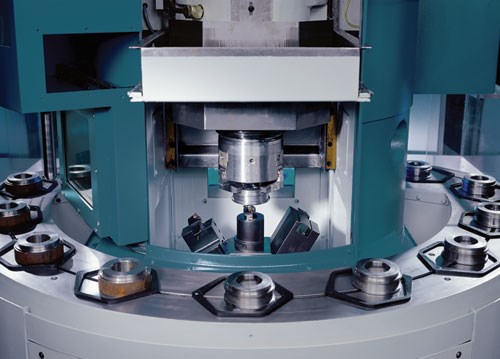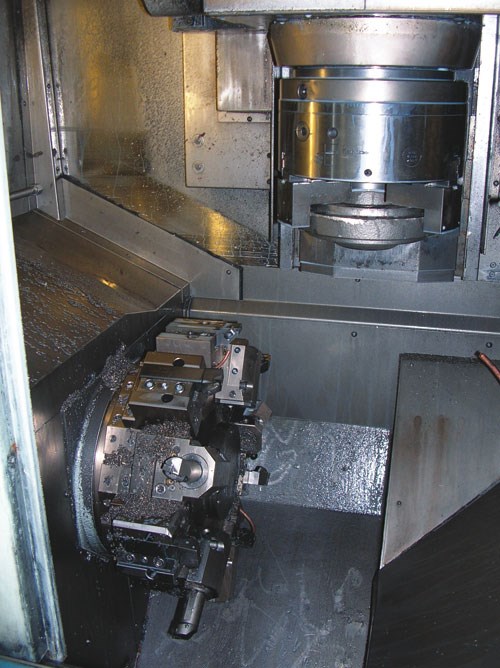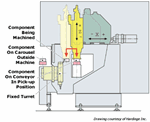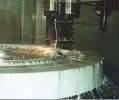A Bird's-Eye View of Vertical Turning
In the right applications, vertical turning can provide significant production benefits through higher capacity, rigidity, versatility, and ease of automation. Here’s a look at several examples of vertical turning at its finest.
A Shop's View of Vertical Turning
Although vertical turning lathes (VTLs) have been around a while, the technology continues to develop to fit the needs of ever changing applications. McSwain Manufacturing Corporation (Cincinnati, Ohio) has 14 VTLs ranging in size from 48 inches to 92 inches in diameter. These machines are used to produce disks of various sizes that will eventually hold turbine blades in gas turbine engines.
The machines give the company an easier way to set large, heavy workpieces and hold them in place for machining. Gravity plays an important role, and only light clamping is necessary. Because of the rigidity of these machines, McSwain is able to hold tolerances of ±0.0005 inch on the diameter, even with cutting forces of 11,000 lbs.
But the company does not only focus on such large parts. It also cuts its share of high-mix, medium-volume, high-precision, small aluminum parts for the aerospace and information technology industries. See how this shop is discovering ways to match the appropriate level of technology with the job at hand.
Turning Turned on End
Imagine taking a CNC horizontal chucker lathe and standing it on end. The inverted vertical turning concept is suitable for a range of small-, med-ium- and large-batch automation applications.
In this design, the inverted spindle moves in both the X and Z axes. A multiple-part conveyor system outside the machining area delivers discrete blanks or near-net-shape parts to a pick-up station, picks up the blank, takes it back to the machining area and presents it to a fixed tool turret for machining. When machining is completed, the spindle returns the finished part to the pick-up station, the conveyor advances to move the next blank to the pick-up station and the cycle repeats.
Small job shops and large manufacturers alike can find an inverted vertical to suit their needs. Read about offerings from an assortment of suppliers.
Vertical Turning Upside Down
A recent development in VTLs, the inverted vertical, or pick-up lathe, turns the tooling and spindle 180 degrees. This design gives the main spindle the capability to load/unload blanks and machine finished parts while letting gravity handle clearing chips and coolant from the manufacturing area.
As a long-time supplier of VTLs and the first developer of the inverted vertical, Emag throws quite a bit of experience into technological advances. Features that lend themselves to high precision and multitasking capabilities can be found in the company’s models that range from dedicated production machines for the automotive market to stand-alone, self-contained turning cells for medium- and small-mix quantities.
A One-Stop Shop
Often, a late addition to a shop’s machine lineup, vertical turning can bring new capabilities that allow a company to expand its customer base. Kadon Precision Machining (Rockford, Ill.) started as a precision screw machine house with three Greenlee machines. Over time, the company grew to include a variety of horizontal and vertical machining centers, single- and twin-spindle horizontal lathes, Swiss-type turning centers and multi-spindle machines, many of which include auto-loaders for efficiency. It was this desire for more automation that led the company down the path towards the addition of a pair of inverted vertical turning lathes.
The machine uses the main spindle as the auto-loader, traversing out of the workzone to an integral conveyor that holds the blank work. On the way, the chuck or collet drops a finished part on a discharge belt, moves to the conveyor, picks up a blank, and then re-enters the workzone. The addition of these machines has played a large role in helping the company be a one-stop shop for all of its customers’ needs.
Related Content
Tips for Troubleshooting and Repairing Chip Conveyors
A nonfunctioning chip conveyor can cause a high-production machine to be down for an extended period of time. Here is some troubleshooting advice if you’re having issues with your chip conveyors.
Read MoreAutomation Breakthroughs Revolutionize Precision Machining for Complex Parts
Marubeni Citizen-Cincom delivers custom solutions to address some of the biggest challenges in precision machining from handling small parts, to robot integration and unique tooling needs.
Read MorePursuit of Parts Collector Spearheads New Enterprise
While searching for a small parts accumulator for Swiss-type lathes, this machine shop CEO not only found what he was looking for but also discovered how to become a distributor for the unique product.
Read MoreAutomation in the Alps: Studer AG Unveils New Grinding Concepts
Studer AG, member company of United Grinding, held its annual press conference at its Swiss Alps location earlier this month to announce its new automatic loaders to accompany its existing grinding machines as well as other offerings and automation features.
Read MoreRead Next
A One Stop Shop
Combining flexible manufacturing with volume production capability helps this shop cover all the bases.
Read MoreA Shop's View Of Vertical Turning
Every metalworking application is different. The challenge for shops is matching the appropriate level of technology to the job at hand. Here's how one job shop uses its vertical turning machines to produce large, heavy and tough workpieces for gas turbine engine applications.
Read MoreTurning Turned On End
Inverted-spindle vertical turning machines take on horizontal chuckers for turning cell applications.
Read More











.jpg;maxWidth=300;quality=90)
.jpg;maxWidth=300;quality=90)











